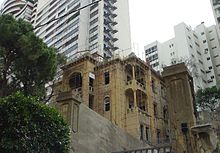Achrafieh: Difference between revisions
m Bot: Migrating 8 interwiki links, now provided by Wikidata on d:q722925 (Report Errors) |
Removed sectarian terminology which is non-conducive to the article. |
||
| Line 7: | Line 7: | ||
[[File:Beirut - Achrafieh - Chartouni Mansion.jpg|thumb|The "Old" and "New" of Achrafieh]] |
[[File:Beirut - Achrafieh - Chartouni Mansion.jpg|thumb|The "Old" and "New" of Achrafieh]] |
||
[[File:Beirut 5.jpg|thumb|The heavy urbanization of Achrafieh]] |
[[File:Beirut 5.jpg|thumb|The heavy urbanization of Achrafieh]] |
||
'''Achrafieh''', ({{lang-ar|الأشرفية}}; also spelled '''Ashrafieh''' and '''Ashafriyeh'''), is one of the oldest |
'''Achrafieh''', ({{lang-ar|الأشرفية}}; also spelled '''Ashrafieh''' and '''Ashafriyeh'''), is one of the oldest districts of East [[Beirut]], [[Lebanon]].<ref>God has ninety-nine names By [[Judith Miller (journalist)|Judith Miller]] Page 246</ref> |
||
==Overview== |
==Overview== |
||
Revision as of 17:42, 25 July 2013
- This article is about a district in Beirut. For the depopulated Palestinian village see Al-Ashrafiyya






Achrafieh, (Arabic: الأشرفية; also spelled Ashrafieh and Ashafriyeh), is one of the oldest districts of East Beirut, Lebanon.[1]
Overview
It is located on a hill in the eastern part of Beirut alongside the shore. Achrafieh is both a residential and commercial district characterized by narrow winding streets and prestigious large apartment and office buildings. It is a prime location for investment and tourism.
Until the 1930s, Achrafieh was largely composed of farmland owned and farmed by several Greek Orthodox Christian families that had ruled the country and the region for centuries. The Lebanese government, which at the time was under French Mandate, partitioned the land in Achrafieh to build roads and highways, forcing these families to eventually sell large parts of their land.
Achrafieh formerly was ruled by seven socially and economically prominent Greek Orthodox Christian families that formed Beirut's High Society for centuries: Trad, Fernaine, Araman, Bustros, Sursock, Fayyad, Tueini.
The area is divided into numerous smaller neighborhoods. Its most prominent ones include: Sassine Square, one of the most prominent political, social and commercial focal points of the Lebanese capital; St Nicolas (where important buildings include the Sursock House, Sursock Museum, the Sofil building and the Ivory building); and Tabaris / Abdel Wahab (among its important buildings: 812 Tabaris, Achrafieh Tower, Yared buildings, Metropolis, L'Hermitage, Sight II, Beirut Heights, Fal Towers, Jardins de Tabaris, 54).
During Lebanon’s civil war, bombs and rockets wiped out a substantial portion of the Achrafieh’s architectural heritage. The war ended and the shooting has stopped, but the destruction of historic buildings has not. Every day, demolition teams tear down old houses and bulldoze hundred-year-old gardens. Tall concrete towers replace the houses, overshadowing the few historical neighborhoods Achrafieh has left. Historic buildings not only hold sentimental value, they are also economically viable.
Archeological remains were found below new buildings, but developers ignored them. Heritage activists are trying their best to preserve the few old remaining ‘Lebanese houses’ still standing in Achraifeh. But their efforts are largely in vain, as there is no law to protect old homes and preservation is low on the list of priorities for the country’s politicians.
During the Lebanese Civil War, which started in 1975, Achrafieh became a major strategic base for Christian forces. Large numbers of Christian Forces militiamen were stationed there, led by Bachir Gemayel, and as such formed part of Christian East Beirut.
It was announced on August 13, 2009 that Achrafieh's neighborhood of Sodeco would be home to Lebanon's tallest tower, Sama Beirut. When the project is completed in 2014 it will be Lebanon's tallest project, standing at 200 metres (660 ft).
Neighborhoods/Streets of Achrafieh
- Sassine Square
- Tabaris
- Gemmayzeh
- Furn el-Hayek
- Abdel-Wahab
- Gouraud
- Monot
- Sodeco
- Sioufi
- Sursock
- Escalier de l'Art
- Rue du Liban
- Rue Huvellin
- Saint Dimitri (Mar Mitr)
See also
- Beirut
- Beirut Central District
- Article on the history of Ashrafieh and how it evolved through time - Interview with Former Ashrafieh MP Michel Sassine (December 2011): http://www.scribd.com/doc/77669439/Interview-on-the-History-of-Achrafieh-with-HE-Michel-Sassine-Dec-2011
- Grand Lycée Franco-Libanais, a French language secondary school, Les Diablotins, Universite Saint Joseph located in the neighbourhood
mar meter strhit (saint Dimitri)
References
- ^ God has ninety-nine names By Judith Miller Page 246
33°53′15.21″N 35°31′14.72″E / 33.8875583°N 35.5207556°E
